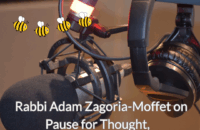My Talmud Journey

Four years ago Rabbi Daniella Kolodny pushed me into my first Talmud shiur. I remember resisting her quiet encouragement, thinking all the while – it’s not meant for me. It’s meant for boys who go to Yeshiva, not secular people who write advertising for shampoo. I saw the Talmud as a big dusty book for men with long beards, not middle-aged women who wear skinny jeans.But I took a chance that my friend Daniella might know something that I didn’t. I went to the Shiur and something happened in that two-hour class that stuck, although I didn’t have the foggiest idea what they were talking about.Since then, I have become more and more obsessed with the Talmud. In fact, I have become one of those nerds who stand in the corner at parties with other Talmud nerds, going on and on about extremely obscure things we’ve learned recently.I’m not chiefly interested in it as a source of history or Halacha, although it is those things too. I love on its own terms as a majestic, artistic creation that is the beating heart of Rabbinic Judaism. I have come to understand that it works like a battery with a negative and a positive charge, between two disputing voices, between the lenient House of Hillel and the strict house of Shammai, between the received tradition from Palestine and the lived tradition in Babylon, and the driving force is sourced between these two sides. In a true post-modern way, the dialectic contains a multiplicity of truths or as they like to say in the Talmud: ‘EYLU V’ EYLU’ or ‘THESE AND THESE ARE BOTH THE WORDS OF THE LIVING GOD’I love it. I very often don’t follow the elaborate and complex halachic argumentation or understand what the stories mean exactly, but I love it anyway. I feel relieved that the conceptual world has been mapped out so creatively and thoroughly. How high, how low, how fast, half-done, on purpose or by accident has been considered. What counts as Giving and what does Agency entail? What is honour and what is the worst thing you can do to a person?For example, in Rabbi Chaim Weiner’s Kollel we studied chapter 2 of the Tractate Gittin which deals with the Halacha for giving a get for a divorce. We saw how the Talmud goes almost everywhere conceptually. It will decide that giving cannot be considered giving if you throw a get on the floor and then ask your wife to pick it up. The furthest understanding of giving that the Talmud will countenance, is that a man can tuck the get into his back pocket and bend over in front of his wife to give her the get. These are not necessarily moral solutions. They are conceptual explorations mapped onto the real world. This is why the Talmud looks at the scenario of a slave tattooed with the get tied to a tree. Not because that would ever happen in the real world (at least not today) but because the Talmud is interested in the conceptual world of giving. So detailed is the discussion in the Talmud that the eight words related to divorce in the Torah, ‘AND YOU SHALL WRITE HER A TEXT OF DIVORCE AND PUT IT IN HER HAND’ are spun out into two thick volumes of discussion.But there are the limits on the vast conversation too. Rule number one is mandatory multiplicity of truth. Rule number two is you have to know when to stop. We learn rule number one from Rabbi Eliezer who is thrown out of the study hall in the famous Oven of Akhnai story for owning the singular space that is God-given truth (Bava Metzia 59a-b). The moral of that story is that God does not decide the rules on earth today, we do.We learn lesson number two from poor Rabbi Jeremiah who is also kicked out of the study-hall for going too far towards abstraction. In Baba Batra 23b Rabbi Jeremiah asks who owns a hopping bird that is found with one foot in and one foot outside a 50-cubit boundary. There is an internal understanding that the conversation can go too far towards the infinity of mapping the field. Enough is enough. Out you go Rabbi Jeremiah and take your hopping bird with you, for not knowing when to stop!Within those boundaries, a fascinating conversation happens in the Talmud that includes me, although it wasn’t written for me. I’ve come a long way since that first Talmud shiur four years ago. Mostly I have learned that this formative Jewish text is not just for yeshiva boys but for anyone who understands that their truth isn’t the only truth, and that good judgement, a good laugh and knowing when to stop, are absolutely essential.
Janine Stein is a member of New North London Synagogue. She is currently completing an MA in Jewish Studies and writing a dissertation on audacity in the Talmud.




